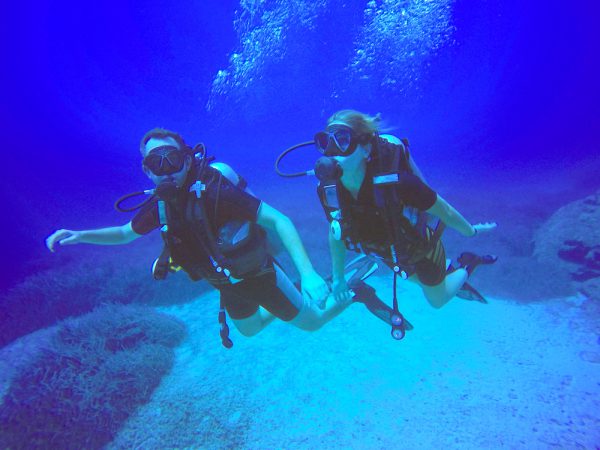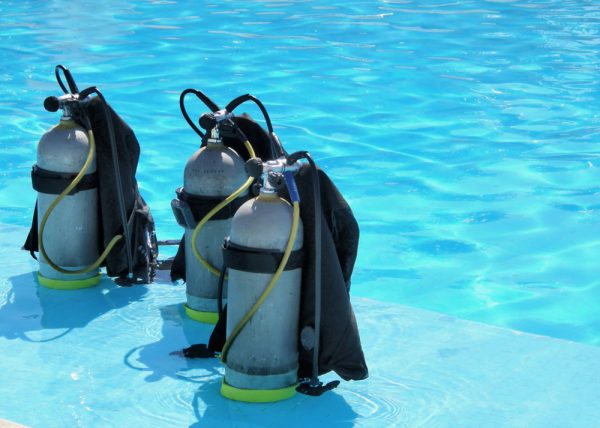If you are a new or novice diver these 5 of the Best Scuba Diving Safety Rules will reinforce your training. If you’re an experienced diver, this can be an excellent refresher experience.
I hope three short videos that I know you will enjoy watching.
Diving is actually a safe sport but like any sport, accidents and injuries can happen. As certified divers, we are aware of the risks and it’s these challenges that make us enjoy it more.
We get in-depth training on the theory and safety techniques. With our dive equipment, we practise our skills in open water. However, in the real dive world, we enjoy our dives so much that complacency sets in. This is where the danger begins when we forget some of the safety rules.
A Lesson Learned
It was the morning of August 17th, 2006, in Grand Turk, Turks and Caicos Islands .
It happened during our first morning dive. I felt someone tug my arm and thinking it was my buddy I quickly turned around.
It was another diver looking at me with big wide-open eyes. Without warning, he grabbed my regulator pulling it out of my mouth.
He was flailing his arms so much that I really thought he was going to hit me.
He pulled his regulator out of his mouth and that’s when I realized he needed air. I immediately grabbed my backup regulator and stuck it in my mouth. I gave him the hand signal to relax and take some deep breaths and thankfully he started to calm down.
I forgot about my dive buddy. When I looked around for him, he had already located this diver’s buddy and together the four of us made our slow ascent. Thankfully, there was enough air in my tank to do a safety stop before surfacing.
The lesson learned here was the diver who needed air hadn’t been checking his air gauge often enough and was diving too far away from his buddy.
It’s so easy to get distracted. We see even the tiniest cute sea creatures hiding among beautiful coral reefs and forget some of our most important basic training.
Let’s get started…
Best Safety Rules In Scuba Diving – Helpful For All Divers
There are more than 5 rules when it comes to scuba diving. I chose these because, in my mind, they are the golden ones and should not be forgotten.
(Currently, I’m just in the middle of revamping some old posts so I added an extra rule.)
1. Scuba Diving Safety Rules – Don’t Put Your Hand In A Hole
Sometimes when we’re underwater, there’s always curiosity when we see a hole hidden in among the lush coral reef. What’s lurking inside?
It’s always been my thought and a good general rule, that you’re better off not to pet, touch or feed the natural underwater wildlife. Some sea creatures have large teeth or tight pinching claws.
If you get too close or frighten them, they might bite or nip you which could cause an infection.
Remember these beautiful nocturnal creatures like eels, crabs and lobsters go into hiding, in holes and crevices. It’s because they’re resting and are shy and want to stay away from humans and natural predators.
Eels don’t have great eyesight and I’m sure that if you were to put your hand in a hole, don’t be surprised if you have it latch onto your fingers. ‘Ouch’!
It’s much better to enjoy watching them and giving them respect in their underwater world.
2. Scuba Diving Safety Rules – Dive Within Your Limits
Would you go on a cave dive with no technical training? I hope not.
Just because you have your Open Water Diver Certification doesn’t mean you’re skilled enough to do what technical divers do. It wouldn’t be wise to climb Mount Everest with no training and no preparation, right?
Wrecks, caves, deep diving, and breathing enriched gas all require special training in skills and knowledge.
Different hazards such as silt stirred by your fins can cause visibility challenges and disorientation.
Your dive light stopped working and now you have sudden darkness with an overhead ceiling. What if you and your buddy got caught in a strong current and you’re accidentally diving deeper than you should.
How prepared are you if any of these were to happen to you?
Scuba diving is supposed to be enjoyable and sometimes peer pressure from your dive friends may cause you to undertake certain dive types you’re not comfortable with.
Even weather can change making dive conditions physically demanding so don’t be afraid to change your plans and say no.
Never dive beyond your comfort zone, dive into what you’re mentally and physically able to handle. For any type of diving, one of the most important skills you’ll want to have is your buoyancy and breathing in control.
Either get the proper technical training before you expand your dive visions or say no if you’re not up to the challenge! Your life and your buddy’s life are not worth losing!
3. Scuba Diving Safety Rules – Never Dive Alone

Some divers want to dive alone. There are many solo divers who enjoy solitude and want to be in their own thoughts and not have to think of their dive buddy. I get that feeling!
Some will dive on their own because they don’t have a dive buddy. This is not recommended even if you are an experienced diver. If you run out of air, for example, you have no one to help you underwater.
Another example is being tangled in fish nets and you can’t free your hands to reach for your knife. Yes, your buddy can help you escape.
If you’re a new or novice diver, certainly, it’s advised not to dive alone and we learn this as an important rule in our Open Water Diver Certification right from the beginning and in all of our other dive courses.
I’m a solo traveller mainly because my friends either don’t dive or are unable to dive because of family commitments. Most of the time, I book my dives with a reputable dive shop, dive resort or liveaboard. When you’re on the boat, it’s easy to find a partner and make a dive plan using our dive experiences.
Never dive alone!
4. Scuba Diving Safety Rules – Come Back With At Least 500 psi/34 Bars In the Tank

The most important consideration is to ensure you come back with enough air in your tank.
500 psi or 34 bars of air in your tank is a good guide and you should be ready to slowly ascend and have enough air to do your safety stop as a recreational diver.
It’s not just about your safety. You also need to think of your dive buddy. Think about having enough air in your tank in the event you must share the air in your tank. This includes activities of slow ascents, safety stops and consideration for any other dive emergencies.
What if you run into some unexpected current or the water temperature is colder? Most definitely you will be consuming air faster.
If you do deep dives, remember you and your buddy will consume more air, so you have to allow for a longer ascent time and safety stop times.
One of the rules that have always worked well for me is to save ⅓ of the air in my tank for going out and another ⅓ of the air for my return. The balance is for safety considerations like the ones I mentioned above.
Now, this rule doesn’t necessarily apply to drift diving because where you start from is not where you will end up. You just drift until it’s time to come up. Your boat captain will see the orange inflated sausage spring up at the surface and be there to pick you up.
Remember to check your air gauge frequently and communicate this back to your buddy, who returns the same.
5. Scuba Diving Safety Rules – Never Panic
This video is a scenario, not an actual accident!
Should this happen, pay attention to your inner feelings because this will help you stop your fear before it reaches a dangerous point.
The panic symptoms can be:
- Fear of dying
- Fear of losing control
- Hyperventilation
- Chest tightening
Remember what you were taught in your Open Water Diver Certification. Stop, think then act by ‘relaxing and taking long deep breaths. Did you know it’s almost impossible to panic by following this procedure?
6. Scuba Diving Safety Rules – Pre-Dive Equipment Inspection
If you haven’t been diving for a while, you will want to ensure every piece of your dive equipment is inspected. This includes the rental tank at the dive shop.
Look for rips and tears in your BCD, wetsuit and/or drysuit.
In fact, even if you skip a few years of diving, you should get your regulator inspected yearly by your local dive shop. They’ll check the hoses and the valves. If you live close to an ocean, just think of how much salt is in the air so get your regulator cleaned.
If your BCD is not inspected properly, you could potentially end up with a runaway ascent. This happens when the inflator valve is stuck in its open position causing your BCD to quickly fill up with air. This is not a fun situation to be in.
Tip: If it happens, pull on your quick dumps to release the air. Disconnect the low pressure hose to stop the air from filling your BCD. If you’re not familiar enough with your BCD gear, then create a drag by flaring out your arms and legs to slow your ascent .
Your dive equipment is an expensive asset and so you want to maintain them with care, just like your vehicle. By doing this, when you’re ready to dive, you can feel safe without having surprises during your dive.
Don’t forget to do your buddy check before you enter the water.
Lots Of Other Safety Dive Rules
I know there are lots of other dive rules but these are the ones I particularly wanted to touch on. We already know not to hold our breath and not to do quick ascents faster than our bubbles.
What would you like to add here? What lessons have you learned from your diving experiences? I hope you share your stories here because we can all learn from them. If you have any questions or comments, it would be awesome to hear from you.
Thanks for reading!
Monica
